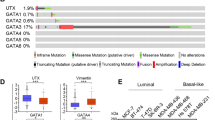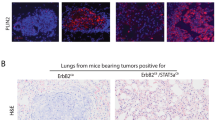Abstract
The nuclear LIM-only protein 4 (LMO4) is upregulated in breast cancer, especially estrogen receptor-negative tumors, and its overexpression in mice leads to hyperplasia and tumor formation. Here, we show that deletion of LMO4 in the mammary glands of mice leads to impaired lobuloalveolar development due to decreased epithelial cell proliferation. With the goal of discovering potential LMO4-target genes, we also developed a conditional expression system in MCF-7 cells for both LMO4 and a dominant negative (DN) form of its co-regulator, cofactor of LIM domains (Clim/Ldb/Nli). We then used DNA microarrays to identify genes responsive to LMO4 and DN-Clim upregulation. One of the genes common to both data sets was bone morphogenic protein 7 (BMP7), whose expression is also significantly correlated with LMO4 transcript levels in a large dataset of human breast cancers, suggesting that BMP7 is a bona fide target gene of LMO4 in breast cancer. Inhibition of BMP7 partially blocks the effects of LMO4 on apoptosis, indicating that BMP7 mediates at least some functions of LMO4. Gene transfer studies show that LMO4 regulates the BMP7 promoter, and chromatin immunoprecipitation studies show that LMO4 and its cofactor Clim2 are recruited to the BMP7 promoter. Furthermore, we demonstrate that HDAC2 recruitment to the BMP7 promoter is inhibited by upregulation of LMO4 and that HDAC2 knockdown upregulates the promoter. These studies suggest a novel mechanism of action for LMO4: LMO4, Clim2 and HDAC2 are part of a transcriptional complex, and increased LMO4 levels can disrupt the complex, leading to decreased HDAC2 recruitment and increased promoter activity.
This is a preview of subscription content, access via your institution
Access options
Subscribe to this journal
Receive 50 print issues and online access
$259.00 per year
only $5.18 per issue
Buy this article
- Purchase on Springer Link
- Instant access to full article PDF
Prices may be subject to local taxes which are calculated during checkout






Similar content being viewed by others
References
Alarmo EL, Rauta J, Kauraniemi P, Karhu R, Kuukasjarvi T, Kallioniemi A . (2006). Bone morphogenetic protein 7 is widely overexpressed in primary breast cancer. Genes Chromosomes Cancer 45: 411–419.
Augsburger A, Schuchardt A, Hoskins S, Dodd J, Butler S . (1999). BMPs as mediators of roof plate repulsion of commissural neurons. Neuron 24: 127–141.
Bach I . (2000). The LIM domain: regulation by association. Mech Dev 91: 5–17.
Baldi P, Long AD . (2001). A Bayesian framework for the analysis of microarray expression data: regularized t-test and statistical inferences of gene changes. Bioinformatics 17: 509–519.
Cheng N, Bhowmick NA, Chytil A, Gorksa AE, Brown KA, Muraoka R et al. (2005). Loss of TGF-beta type II receptor in fibroblasts promotes mammary carcinoma growth and invasion through upregulation of TGF-alpha-, MSP- and HGF-mediated signaling networks. Oncogene 24: 5053–5068.
Chi S, Kitanaka C, Noguchi K, Mochizuki T, Nagashima Y, Shirouzu M et al. (1999). Oncogenic Ras triggers cell suicide through the activation of a caspase-independent cell death program in human cancer cells. Oncogene 18: 2281–2290.
Dean C, Ito M, Makarenkova HP, Faber SC, Lang RA . (2004). Bmp7 regulates branching morphogenesis of the lacrimal gland by promoting mesenchymal proliferation and condensation. Development 131: 4155–4165.
Deane JE, Ryan DP, Sunde M, Maher MJ, Guss JM, Visvader JE et al. (2004). Tandem LIM domains provide synergistic binding in the LMO4:Ldb1 complex. EMBO J 23: 3589–3598.
Dennis Jr G, Sherman BT, Hosack DA, Yang J, Gao W, Lane HC et al. (2003). DAVID: Database for annotation, visualization, and integrated discovery. Genome Biol 4: P3.
Farmer P, Bonnefoi H, Becette V, Tubiana-Hulin M, Fumoleau P, Larsimont D et al. (2005). Identification of molecular apocrine breast tumours by microarray analysis. Oncogene 24: 4660–4671.
Gruvberger S, Ringner M, Chen Y, Panavally S, Saal LH, Borg A et al. (2001). Estrogen receptor status in breast cancer is associated with remarkably distinct gene expression patterns. Cancer Res 61: 5979–5984.
Hahm K, Sum EY, Fujiwara Y, Lindeman GJ, Visvader JE, Orkin SH . (2004). Defective neural tube closure and anteroposterior patterning in mice lacking the LIM protein LMO4 or its interacting partner Deaf-1. Mol Cell Biol 24: 2074–2082.
Hogan BL . (1996). Bone morphogenetic proteins: multifunctional regulators of vertebrate development. Genes Dev 10: 1580–1594.
Jurata LW, Pfaff SL, Gill GN . (1998). The nuclear LIM domain interactor NLI mediates homo- and heterodimerization of LIM domain transcription factors. J Biol Chem 273: 3152–3157.
Kawai S, Sugiura T . (2001). Characterization of human bone morphogenetic protein (BMP)-4 and -7 gene promoters: activation of BMP promoters by Gli, a sonic hedgehog mediator. Bone 29: 54–61.
Kusumegi T, Tanaka J, Kawano M, Yonemoto J, Tohyama C, Sone H . (2004). BMP7/ActRIIB regulates estrogen-dependent apoptosis: new biomarkers for environmental estrogens. J Biochem Mol Toxicol 18: 1–11.
Landis MD, Seachrist DD, Montanez-Wiscovich ME, Danielpour D, Keri RA . (2005). Gene expression profiling of cancer progression reveals intrinsic regulation of transforming growth factor-beta signaling in ErbB2/Neu-induced tumors from transgenic mice. Oncogene 24: 5173–5190.
Lee SK, Jurata LW, Nowak R, Lettieri K, Kenny DA, Pfaff SL et al. (2005). The LIM domain-only protein LMO4 is required for neural tube closure. Mol Cell Neurosci 28: 205–214.
Lu Z, Lam KS, Wang N, Xu X, Cortes M, Andersen B . (2006). LMO4 can interact with Smad proteins and modulate transforming growth factor-beta signaling in epithelial cells. Oncogene 25: 2920–2930.
Luo G, Hofmann C, Bronckers AL, Sohocki M, Bradley A, Karsenty G . (1995). BMP-7 is an inducer of nephrogenesis, and is also required for eye development and skeletal patterning. Genes Dev 9: 2808–2820.
Maeda S, Kamata H, Luo JL, Leffert H, Karin M . (2005). IKKbeta couples hepatocyte death to cytokine-driven compensatory proliferation that promotes chemical hepatocarcinogenesis. Cell 121: 977–990.
Milan M, Diaz-Benjumea FJ, Cohen SM . (1998). Beadex encodes an LMO protein that regulates Apterous LIM-homeodomain activity in Drosophila wing development: a model for LMO oncogene function. Genes Dev 12: 2912–2920.
Mizunuma H, Miyazawa J, Sanada K, Imai K . (2003). The LIM-only protein, LMO4, and the LIM domain-binding protein, LDB1, expression in squamous cell carcinomas of the oral cavity. Br J Cancer 88: 1543–1548.
Monroe DG, Jin DF, Sanders MM . (2000). Estrogen opposes the apoptotic effects of bone morphogenetic protein 7 on tissue remodeling. Mol Cell Biol 20: 4626–4634.
Mousses S, Bubendorf L, Wagner U, Hostetter G, Kononen J, Cornelison R et al. (2002). Clinical validation of candidate genes associated with prostate cancer progression in the CWR22 model system using tissue microarrays. Cancer Res 62: 1256–1260.
Pelengaris S, Khan M, Evan G . (2002). c-MYC: more than just a matter of life and death. Nat Rev Cancer 2: 764–776.
Rabbitts TH, Bucher K, Chung G, Grutz G, Warren A, Yamada Y . (1999). The effect of chromosomal translocations in acute leukemias: the LMO2 paradigm in transcription and development. Cancer Res 59: 1794s–1798s.
Ryan DP, Sunde M, Kwan AH, Marianayagam NJ, Nancarrow AL, Vanden Hoven RN et al. (2006). Identification of the key LMO2-binding determinants on Ldb1. J Mol Biol 359: 66–75.
Singh RR, Barnes CJ, Talukder AH, Fuqua SA, Kumar R . (2005). Negative regulation of estrogen receptor alpha transactivation functions by LIM domain only 4 protein. Cancer Res 65: 10594–10601.
Sugihara TM, Bach I, Kioussi C, Rosenfeld MG, Andersen B . (1998). Mouse deformed epidermal autoregulatory factor 1 recruits a LIM domain factor, LMO-4, and CLIM coregulators. Proc Natl Acad Sci USA 95: 15418–15423.
Sum EY, O'Reilly LA, Jonas N, Lindeman GJ, Visvader JE . (2005a). The LIM domain protein Lmo4 is highly expressed in proliferating mouse epithelial tissues. J Histochem Cytochem 53: 475–486.
Sum EY, Segara D, Duscio B, Bath ML, Field AS, Sutherland RL et al. (2005b). Overexpression of LMO4 induces mammary hyperplasia, promotes cell invasion, and is a predictor of poor outcome in breast cancer. Proc Natl Acad Sci USA 102: 7659–7664.
Sum EY, Shackleton M, Hahm K, Thomas RM, O'Reilly LA, Wagner KU et al. (2005c). Loss of the LIM domain protein Lmo4 in the mammary gland during pregnancy impedes lobuloalveolar development. Oncogene 24: 4820–4828.
Visvader JE, Venter D, Hahm K, Santamaria M, Sum EY, O'Reilly L et al. (2001). The LIM domain gene LMO4 inhibits differentiation of mammary epithelial cells in vitro and is overexpressed in breast cancer. Proc Natl Acad Sci USA 98: 14452–14457.
Wagner KU, Wall RJ, St-Onge L, Gruss P, Wynshaw-Boris A, Garrett L et al. (1997). Cre-mediated gene deletion in the mammary gland. Nucleic Acids Res 25: 4323–4330.
Wang N, Kudryavtseva E, Ch'en IL, McCormick J, Sugihara TM, Ruiz R et al. (2004). Expression of an engrailed-LMO4 fusion protein in mammary epithelial cells inhibits mammary gland development in mice. Oncogene 23: 1507–1513.
Acknowledgements
This study was supported by NIH Grant AR44882 and the Irving Weinstein Foundation (BA); the Breast Cancer Research Program of the US Army Medical Research and Material Command (NW and ZL); and the California Breast Cancer Research Program (ZY and XX). We thank Hung Lin for PCR, Julie Fernandez for cell culture, UCI Microarray Core Facility for microarray experiments, and Rainer Brachman, Xing Dai, Steve Lipkin and Marian Waterman for reading the manuscript.
Author information
Authors and Affiliations
Corresponding author
Additional information
Supplementary Information accompanies the paper on the Oncogene website (http://www.nature.com/onc).
Supplementary information
Rights and permissions
About this article
Cite this article
Wang, N., Lin, K., Lu, Z. et al. The LIM-only factor LMO4 regulates expression of the BMP7 gene through an HDAC2-dependent mechanism, and controls cell proliferation and apoptosis of mammary epithelial cells. Oncogene 26, 6431–6441 (2007). https://doi.org/10.1038/sj.onc.1210465
Received:
Revised:
Accepted:
Published:
Issue Date:
DOI: https://doi.org/10.1038/sj.onc.1210465
Keywords
This article is cited by
-
Human umbilical cord mesenchymal stem cell-derived extracellular vesicles carrying miR-655-3p inhibit the development of esophageal cancer by regulating the expression of HIF-1α via a LMO4/HDAC2-dependent mechanism
Cell Biology and Toxicology (2023)
-
Lmo4 Deficiency Enhances Susceptibility to Cisplatin-Induced Cochlear Apoptosis and Hearing Loss
Molecular Neurobiology (2021)
-
Cisplatin-induced apoptosis in auditory, renal, and neuronal cells is associated with nitration and downregulation of LMO4
Cell Death Discovery (2015)
-
LIM-domain-only proteins: multifunctional nuclear transcription coregulators that interacts with diverse proteins
Molecular Biology Reports (2014)
-
LIM-domain-only proteins in cancer
Nature Reviews Cancer (2013)



